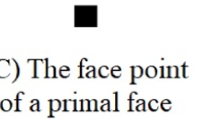Abstract
This paper presents an \(hp\)-adaptive flux-corrected transport algorithm for continuous finite elements. The proposed approach is based on a continuous Galerkin approximation with unconstrained higher-order elements in smooth regions and constrained \(P_1/Q_1\) elements in the neighborhood of steep fronts. Smooth elements are found using a hierarchical smoothness indicator based on discontinuous higher-order reconstructions. A gradient-based error indicator determines the local mesh size \(h\) and polynomial degree \(p\). The discrete maximum principle for linear/bilinear finite elements is enforced using a linearized flux-corrected transport (FCT) algorithm. The same limiting strategy is employed when it comes to constraining the \(L^2\) projection of data from one finite-dimensional space into another. The new algorithm is implemented in the open-source software package Hermes. The use of hierarchical data structures that support arbitrary-level hanging nodes makes the extension of FCT to \(hp\)-FEM relatively straightforward. The accuracy of the proposed method is illustrated by a numerical study for a two-dimensional benchmark problem with a known exact solution.










Similar content being viewed by others
References
Davis TA (2004) Algorithm 832: Umfpack v4.3–an unsymmetric-pattern multifrontal method. ACM Trans Math Softw 30(2):196–199. doi:10.1145/992200.992206. http://www.doi.acm.org/10.1145.992200.992206
John V, Schmeyer E (2008) On finite element methods for 3d time-dependent convection-diffusion-reaction equations with small diffusion. Comput Methods Appl Mech Engrg 198:475–494
Kirk B, Peterson J, Stogner R, Carey G (2006) libMesh: a C++ Library for parallel adaptive mesh refinement/coarsening simulations. Eng Comput 22(3–4):237–254
Kus P (2011) Automatic hp-adaptivity on meshes with arbitrary-level hanging nodes in 3d. PhD thesis, Charles University, Prague.
Kuzmin D (2008) On the design of algebraic flux correction schemes for quadratic finite elements. Comput Appl Math 218:1:79–87
Kuzmin D (2010) A vertex-based hierarchical slope limiter for p-adaptive discontinuous galerkin methods. J Comput Appl Math 233(12):3077–3085. doi:10.1016/j.cam.2009.05.028
Kuzmin D (2011) Slope limiting for discontinuous Galerkin approximations with a possibly non-orthogonal taylor basis. Int J Numer Methods Fluids 1:1–12 (Ergebnisberichte Angew. Math. 430, TU Dortmund)
Kuzmin D (2012) Algebraic flux correction. I. Scalar conservation laws. In: Kuzmin D, Löhner R, Turek S (eds) Flux-corrected transport: principles, algorithms, and applications, 2nd edn, Springer, Berlin
Kuzmin D, Möller M, Shadid JN, Shashkov M (2010) Failsafe flux limiting and constrained data projections for equations of gas dynamics. J Comput Phys 229(23):8766–8779. doi:10.1016/j.jcp. 2010.08.009
Kuzmin D, Schieweck F (2012) A parameter-free smoothness indicator for high-resolution finite element schemes. Submitted to the CEJM topical issue “Numerical Methods for Large Scale Scientific Computing” in February 2012
Kuzmin D, Turek S (2002) Flux correction tools for finite elements. J Comput Phys 175:525–558
LeVeque R (1996) High-resolution conservative algorithms for advection in incompressible flow. SIAM J Numer Anal 33:627–665
Michoski C, Mirabito C, Dawson C, Wirasaet D, Kubatko E, Westerink J (2010) Adaptive hierarchic transformations for dynamically p-enriched slope-limiting over discontinuous galerkin systems of generalized equations. J Comput Phys 230:8028–8056
Solin P et al. (2012) Hermes-higher-order modular finite element system (user’s guide). http://www.hpfem.org/
Solin P, Cerveny J (2006) Automatic hp-adaptivity with arbitrary-level hanging nodes. Research report. University of Texas, E1 Paso
Solin P, Cerveny J, Dolezel I (2008) Arbitrary-level hanging nodes and automatic adaptivity in the hp-fem. Math Comput Simul 77:117–132
Solin P, Segeth K, Dolezel I (2003) Higher-order finite element methods. Chapman and Hall/CRC Press, Boca Raton
Zalesak S (1979) Fully multidimensional flux-corrected transport algorithms for fluids. J Comput Phys 31:335–362
Zienkiewicz O, Zhu J (1987) A simple error estimator and adaptive procedure for practical engineering analysis. Int J Numer Methods Engrg 24:2:337–357
Acknowledgments
This research was supported by the German Research Association (DFG) under Grant KU 1530/6-1.
Author information
Authors and Affiliations
Corresponding author
Rights and permissions
About this article
Cite this article
Bittl, M., Kuzmin, D. An \(hp\)-adaptive flux-corrected transport algorithm for continuous finite elements. Computing 95 (Suppl 1), 27–48 (2013). https://doi.org/10.1007/s00607-012-0223-y
Received:
Accepted:
Published:
Issue Date:
DOI: https://doi.org/10.1007/s00607-012-0223-y




